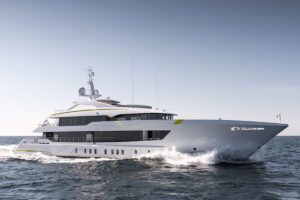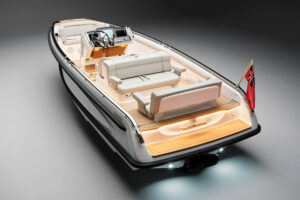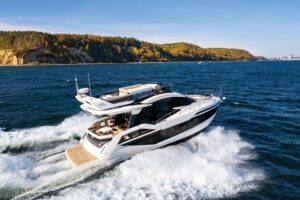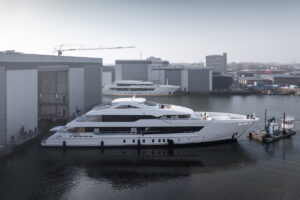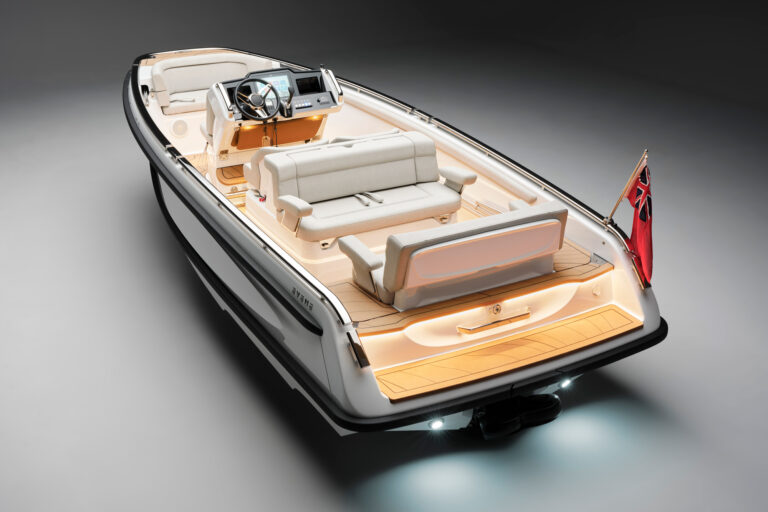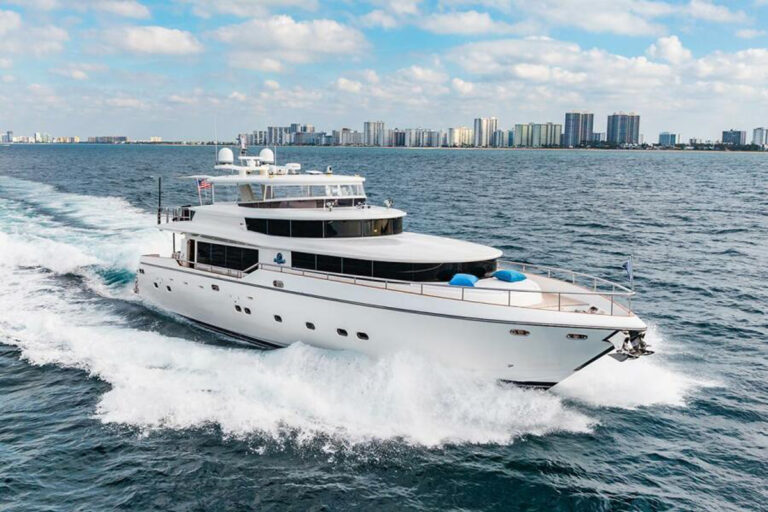Molded fiberglass has become a popular medium for yachts in the 100- to 125-foot class. This is in no small part a result of the efforts of the designers and craftsmen of the Pacific Northwest. While NorthStar is a relatively new team on the field, it is a composite of the pool of talent that resides in the region. The company’s new 105-foot Tri-Deck Motoryacht is a reflection of this heritage.
Jerry Clark, a third generation boatbuilder who worked his way up from the production floor to management, founded NorthStar in 1998. With two capable partners, Clark set up shop in Kalama, Washington, just a few miles from the old Tollycraft facility that closed its doors in the late 1990’s. In addition to acquiring the builder’s tooling, Clark provided a creative outlet for the craftsmen that had used it.
Little of the Tollycraft tooling proved useful. However, today 95 percent of NorthStar’s workforce are former Tollycraft employees with an average tenure of 15 years experience in yacht building. While these folks may have cut their teeth in production boat building, their transition to the semi-custom yacht business has been seamless.
The 105’s hull is one of a series from 92 to 115 feet with beams of 22 feet, 10 inches to 24 feet even and all are produced in an adjustable female mold. This multipurpose tooling method was pioneered and perfected by the builders in this region. The advantage is simple. In NorthStar’s case, one mold can produce hulls for five different models.
NorthStar’s superstructures are built in segmented molds that also allow cross-platform flexibility. As is the case with the hull mold, this tooling was built without costly male plugs. Thanks to these techniques, large semi-custom yachts built of fiberglass are economically viable.
The 105’s hull bottom is hand laminated with multi-directional stitched reinforcement and 11/2-inch Core-Cell, while 1-inch Core-Cell is used in the hull sides. The outer skin is laminated with vinylester resin and has an impressive gelcoat finish. Stringers are laminated by hand over foam forms, and four 2-inch-thick cored structural bulkheads are bonded to the hull. Coring is used to stiffen the superstructure and decks as well as the interior soles. All core materials are vacuum-bagged in place.
Fuel tankage is aluminum, which seems odd considering NorthStar’s expertise with fiberglass. Production builders and age have proven fiberglass tanks virtually indestructible. Clark suggests that aluminum remains the material of choice for fuel tanks as it suits the semi-custom environment and is relatively light and easy to work with.
A fuel manifold in the engine room allows fuel to be drawn or returned to any of the 105’s tanks. Eight hundred gallons of water is carried in stainless steel tanks that are supplemented with a Sea Recovery 1,200 gallon-per-day water maker. Black water and gray water tanks are built of fiberglass.
NorthStar’s 60,000 square foot facility is on the Columbia River. The builder’s 120 employees are capable of producing four yachts a year. Considering NorthStar’s size and the scope of its projects, this is quite efficient. Still, in the scheme of things they are a relatively small company, which Clark sees as an advantage. “Because of our size, we are able to devote more attention to our customer’s individual needs, he says. “This results in a more custom, semi-custom yacht.
The 105 is available with walk-around side decks or a full-beam deckhouse aft. Exterior public areas include an afterdeck seating area, a boat deck lounge with a barbeque and a seating area aft of the flying bridge control station. The cockpit has a transom door and a water-sports platform is fitted.
While her exterior arrangement is more or less defined by her tooling, her interior layout is a different matter. “Within the accommodation space pretty much anything goes, said Clark. NorthStar offers several arrangement plans as a starting point.
Hull number one is a full-beam deckhouse design with boarding from the afterdeck or forward in the galley/country kitchen area. Aft, the deckhouse is an open layout with a saloon, a full service bar and formal dining area. There is a day-head amidships and staircases lead below decks to the accommodation space and above to the pilothouse/sky lounge. In the full side-deck arrangement this central location would serve as an entry foyer.
Owner and guest accommodations are forward of the machinery space and include two staterooms with queen berths and private heads. A third stateroom has upper and lower berths and a private head. A full-beam master stateroom has a king berth and his/hers heads. The satin finished cherry interior is well-executed and complemented by granite surfaces, high quality soft goods and interior hardware.
Crew accommodations on hull number one are forward and include two cabins and a lounge. Access is from the galley area on the main deck. An alternate arrangement positions the crew’s quarters aft of the machinery space with access from the cockpit. While preference is a matter of personal taste, I am a fan of traditional crew-forward designs as they typically allow owner and guests more privacy. On hull number one the area aft of the machinery space is arranged with a crew/kids cabin, a head and a workshop/storage area.
While NorthStar builds a 74-foot Ed Monk Jr. design that evolved from the proven Tollycraft 65, Jack Sarin penned the other designs in its line-up-including the 105. Her slippery semi-displacement hull form is typical of the work that has made Sarin designs a proven standard in the region. Stabilizers are standard equipment as is a bowthruster.
The 105 is available with either 1,400 hp Caterpillar 3412E’s or 1,480 hp MTU 12V-2000’s. Hull number one was equipped with the Cats and NorthStar’s company captain reports a top speed of 22 knots and a cruising speed of 18 knots at 2000 rpm. At 17 knots (1800 rpm) a range of 1,150 nautical miles is expected. At 14 knots (1400 rpm) a range of more than 2,000 nautical miles should be possible. NorthStar expects similar performance with the MTU’s.
The 105 is packaged cruise-ready. “We incorporate realistic allowances for interior décor, electronics and accessories in our pricing”, said Bob Crow, NorthStar’s East Coast sales agent. “It is our goal that when the boat is delivered all you’ll need to bring aboard is a toothbrush.”
The only major options according to Crow are a flying bridge hardtop and a “Med-moor option that includes an upgraded anchoring system and a passerelle. “We do not discourage clients from personalizing the outfitting of their boat, however, we begin with an equipment list that in our experience makes sense.
If you’re looking for a turnkey yacht in this class, NorthStar’s semi-custom program and the 105 make sense, indeed.
Contact: Generation Marine, 954-321-1457; www.northstaryachts.com.

